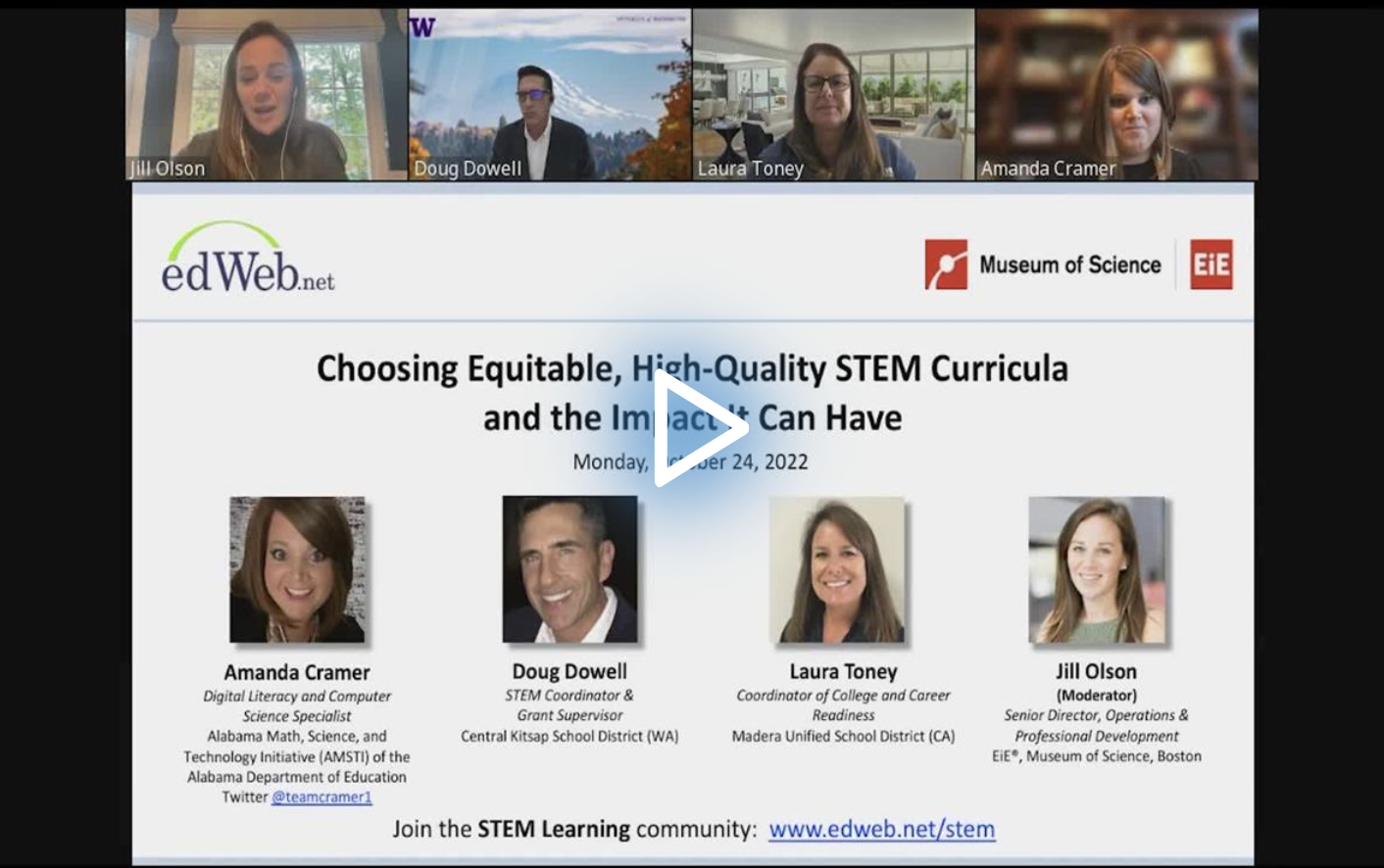How Accessible, High-Quality STEM Programming Benefits All Students
Watch the Recording Listen to the Podcast
In today’s technologically advanced world, workers who are computational thinkers with a firm grasp of science, engineering, math, and technology (STEM) are in high demand. However, preparing today’s students for the work of the future is challenging. Many educators, especially early childhood and elementary teachers, do not have a STEM background so the task of integrating those subjects into daily classroom lessons can feel overwhelming.
In the edLeader Panel, “Choosing Equitable, High-Quality STEM Curricula and the Impact It Can Have,” district- and state-level STEM leaders discussed how to create inclusive and accessible schoolwide STEM programs that benefit all students.
Preparing Educators to Teach STEM
According to Jill Olson, Senior Director of Operations and Professional Development for EiE® from the Museum of Science, Boston, 73% of elementary teachers do not feel adequately prepared to teach engineering, and in a survey of pre-service elementary teachers, only 10% understood the concepts of computational thinking.
In short, most teachers are uncomfortable implementing a STEM curriculum, which requires professional development to ensure they receive the training they need to integrate lessons into their everyday activities.
Creating a High-Quality Professional Development Experience
Laura Toney, Coordinator of College and Career Readiness for Madera Unified School District (CA), explains that high-quality professional development starts with the basics of time management and expectations. The typical elementary teacher does not have a STEM background, which can create a level of anxiety. Creating accessibility and comfort to dispel anxiety or reluctance can take several forms. Suggestions discussed by the panelists included:
- Training in grade-specific cohorts or grade bands so that teachers feel supported
- Ensuring the experience is relevant to the happenings in their classroom
- Acknowledging the time commitment and providing incentives like additional pay or clock hours
Ultimately, the training must meet their needs and help them understand how to integrate the curriculum into the classroom—and it has to be sustainable. It should not be viewed as a one-and-done experience, but rather an ongoing process.
Doug Dowell, STEM Coordinator and Grant Supervisor for Central Kitsap School District (WA), shared that they are working to create that sustainability by having a STEM coach in every building to not only support returning teachers but also new teachers.
Much like students, many teachers learn best when their experiences are hands-on and interactive. Amanda Cramer, Digital Literacy and Computer Science Specialist for the Alabama Math, Science, and Technology Initiative (AMSTI) within the Alabama Department of Education, said that they “work to provide hands-on experiences within our trainings so that they have an experience to tie back to the professional development they’re receiving.” She went on to reinforce that ongoing support in the classroom via coaching or train-the-trainer models provides another level of support that teachers need to embrace the process and build their confidence.
Building Relationships Builds Trust and Confidence
While there might be bumps along the way, the best way to build trust and confidence is through relationship-building exercises. In Madera USD, they set aside 90 minutes every Monday morning for all the STEM teachers to meet as a group via Zoom. They call it their Monday Morning Circle. They use that time to debrief—sharing successes, failures, and insights from the previous week.
When they started these meetings, teachers were hesitant to share, but after the first couple of months, they established a foundation of trust where everyone felt supported, allowing them to lean on each other, trust each other’s strengths and build on weak spots so that they are a well-functioning team.
Engaging, Hands-On PD
An example shared by Dowell of teamwork in action involved professional development training his district did in the summer with EiE. It was designed to be a two-day STEM training on the essentials. One day focused on engineering, where teachers spent the whole day learning the background, engaging in hands-on learning, and seeing it modeled for them. The next day, they did the same process with the computer science units.
The feedback they received from teachers was profound. Prior to the training, their initial comfort with the material was between zero and 10%. After the session, their numbers were off the charts, and they had an amazing comfort level with the material. Not only were they seeing the connections of how it can help with ELA and math, but they were also confident in their ability to integrate it throughout their lesson plans.
Going through an engaging, hands-on process changed mindsets and helped educators recognize that computational thinking is problem solving, which is something they teach to their students every day and something they regularly model for their students.
Helping Parents Understand the Importance of STEM
Parents of elementary students often view reading and math as top priorities, which can make the drive to integrate STEM into the curriculum confusing. Helping parents understand that a STEM curriculum is not supplanting essential subject areas is critical. Administrators and teachers should explain that integrating STEM within the core curriculum will help students:
- Build cognitive strategies
- Develop and expand 21st century learning skills
- Understand computational thinking
- Prepare them for the jobs of the future
Recognizing that many parents have limited high-quality STEM experiences, Cramer shared that the state of Alabama has been sharing resources to help parents have conversations about STEM with their young children. They are focused on giving parents the support they need to help their students develop numeracy and science skills to build a common vocabulary around STEM. The goal is for students to enter elementary school prepared to learn STEM.
In Madera USD, the district sends a weekly newsletter home to the parents as well as a digital version via ParentSquare. The newsletter includes a few basic sentences on what students did that week by grade level and provides prompts for the parents to ask their children specific questions about what they learned.
For instance, a lesson about the effect of drag may have the prompt, “Ask your child about drag and the effect that has on a parachute.” The newsletter also includes a family STEM challenge, which is engaging and fun. The response from parents has been positive, with many expressing their enthusiastic approval of the program.
Open and Accessible STEM Benefits All Students
The heart of a STEM curriculum is that it teaches students to be problem solvers. Dowell says it is “crucial that today’s students grow up to become problem solvers.” With the diversity of today’s student population, he argues that the importance of an equitable education where different people have a “say in STEM is a lot broader than just career opportunity or income.”
Looking through a diversity lens, what works to engage all learners? Toney says when they began their STEM program, they were adamant that they were not going to exclude any students. Her team worked with EiE to build lessons to help each group—from English learners to autistic students to deaf and hard-of-hearing clusters to more traditional special education students.
According to Toney, when the students see others do it and are able to replicate that, STEM suddenly levels the playing field. “We were seeing, five or six weeks into the program, that it wasn’t always the top students excelling at what they were doing…but it was other students able to excel and solve for the problem they were given. It really provided success or confidence in students who don’t always have that opportunity in the academic classroom.”
Another benefit for students is the boost STEM integration can provide on state assessments. Cramer says that students who are exposed to high-quality STEM experiences enter those assessments with an advantage because they have context for many of the questions and how those questions are being framed.
Dowell argues that missing the opportunity to expose kids to a STEM curriculum in the early grades has the potential to deprive them of opportunities later in school and in life. He says “it comes down to a social justice issue…if we don’t give all our kids a chance at being confident and competent STEM learners, we’re closing the door on them because if we wait until middle school, particularly the underserved population, kids of color, kids of poverty, our girls, if they don’t see themselves as STEM capable, we’ve lost them.”
Learn more about this edWeb broadcast, “Choosing Equitable, High-Quality STEM Curricula and the Impact It Can Have,” sponsored by EiE®, Museum of Science, Boston.
Watch the Recording Listen to the Podcast
Join the Community
STEM Learning: Full STEAM Ahead is a free professional learning community that provides educators, curriculum leaders, and industry members with a place to collaborate on bringing more science, technology, engineering, and mathematics into the classroom.
EiE®, Museum of Science develops evidence-based, standards-aligned engineering and computer science programs that empower children to become lifelong STEM learners and passionate problem solvers. We’ve designed our PreK–8 curricula to encourage all children, including those from underrepresented groups, to see themselves in STEM.
Blog post by Ginny Kirkland, based on this edLeader Panel






Comments are closed.